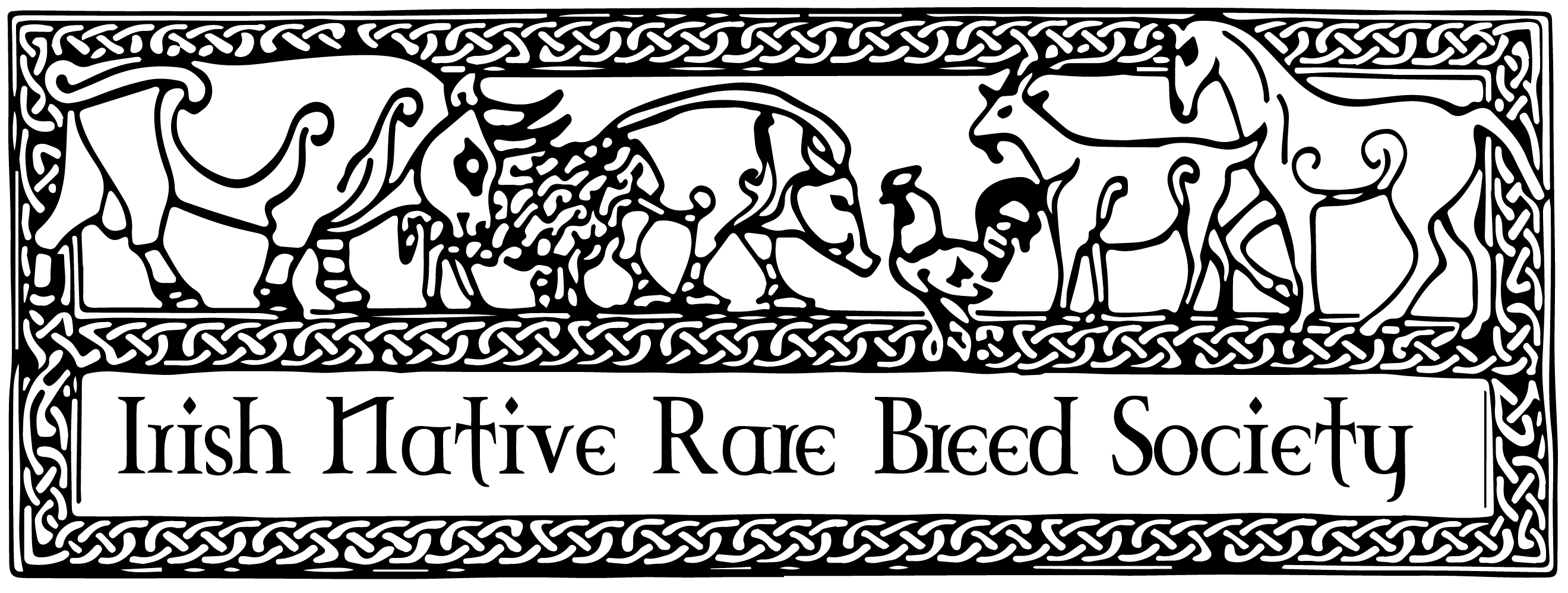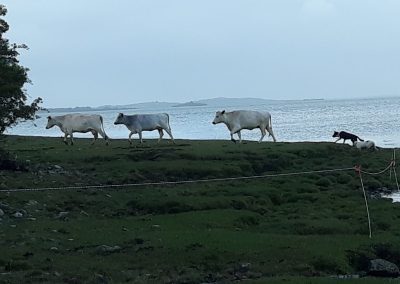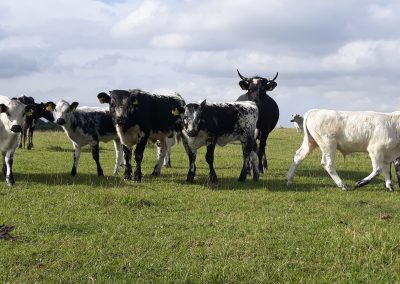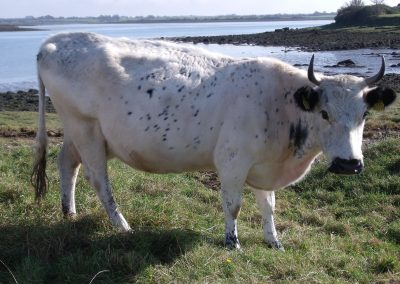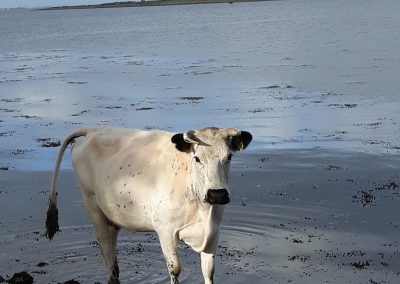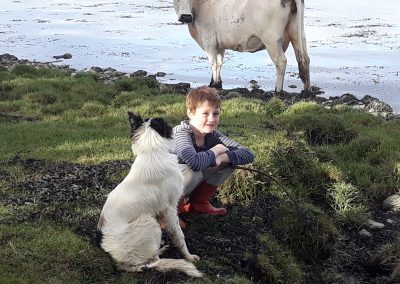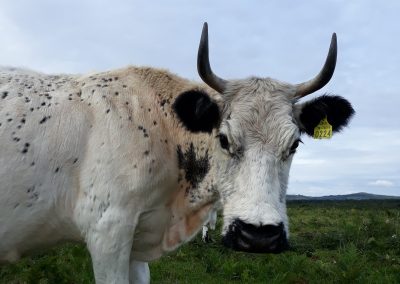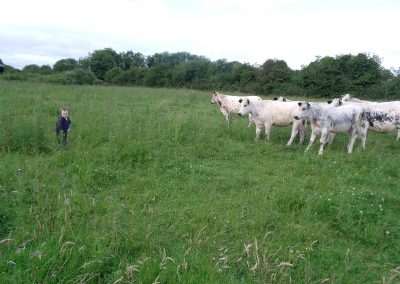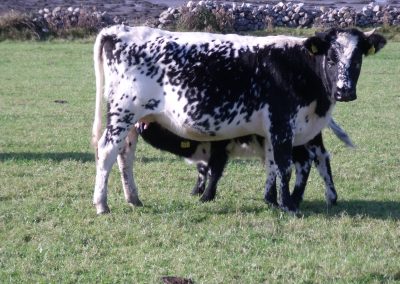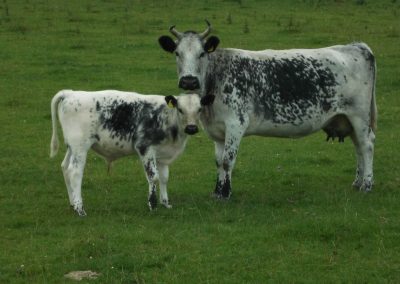Droimeann Cattle and Galway Sheep – Case study
Case study Droimeann Cattle and Galway Sheep – By Tom Keane.
I am a farmer in West Limerick with my lands straddling the Shannon estuary. I have been farming organically since 2002 and have had Droimeann cattle on the farm since 2001 and Galway sheep since 2004. Prior to getting my first Droimeann cattle I had a mixture of conventional breeds and over time as the numbers of Droimeann cattle increased I depopulated the other breeds until by 2013 I had a herd consisting entirely of Droimeann cattle. I first got sheep in 2004, a small flock of pedigree Galways and while down the years I have had some other breeds in addition to Galways, the Galways have always been the mainstay of my flock.
The land that I farm is species rich, with many of the flora present in The Burren present here such as orchids while on the shoreline a range of plants suited to salt marsh grow such as the rare artemisia. About one third of my land is Special Area of Conservation (SAC) on account of bordering on the estuary and I also lease some land nearby which is also SAC as it is composed of calcareous grassland. The soil on both my farm and the leased land is very porous and the limestone is very near the surface and in places the rock is exposed.

I rear my calves in a suckler herd which is mostly outwintered and I rarely finish animals, usually selling males once weaned to finishers or to other breeders looking for stock bulls and all females bar replacement heifers are sold to other breeders. I breed the Galways pure except for the hoggets which I mate with a Charolais ram. Because I have had other breeds of cattle and sheep over the years I am in a position to compare the native breeds that I have with more conventional breeds.
Droimeann cattle are far hardier than conventional cattle and need a lot less care and attention. The fertility of Droimeann cattle is amazing, heifers are capable of getting in calf from five months of age and sometimes younger. As a result I move heifer calves and the cows being suckled by them from the main herd with the stock bull by the time they are five months of age by which time the cow is invariably in calf again and this is where the leased land comes in so useful. Because of the fluctuating heights of the tide and the effects of seaweed being washed up on fencing and the tidal action in knocking stone walls, fencing is a never ending task and the ability to place the heifers at a safe remove from the bull is more easily accomplished in the leased land than in sectioning off my own farm. I don’t go in for exclusively Spring calving, because the cattle are out wintered and there is a bull running with the herd at all times I let nature take its course in this regard with the result that I can get a greater picture of the fertility of the cattle. There have been a few instances where cows have calved at ten month intervals and ten and a half month intervals are not infrequent. This is from cows who are not housed and do not receive any feed other than grass and silage and who are not exposed to mineral supplements or routine administration of medicines as this is an organic farm.
Because there is a history of both redwater and blackleg on the farm I have a derogation on my organic license for vaccination for both of these diseases. Cattle born on the farm and animals bought in as weanlings and younger generally have a resistance to redwater so in general only animals bought in older than weanlings need to be treated with a pour-on, usually I only buy in stock bulls so it is infrequent that I have to apply this. The sheep have a role in preventing redwater as they graze the grass tightly leaving less of the long stemmy grass which accommodates the tic which hosts the pathogen that causes redwater. Also, the sheep keep the ragworth in check, so in addition to the value of the sheep in their own regard they provide a valuable service in keeping parasite hosting grasses and invasive species in check. In the case of blackleg I inject all animals under two years of age or females who have yet to give birth with a vaccine once a year, I do not need to give the booster shot that is recommended. Other than that the cattle need little intervention.
In addition to being hardy and low maintenance and more fertile than other breeds I note that Droimeann cattle generally calve unassisted, the calf is usually on its feet and drinking its mother in a short period of time. The cows have a much stronger maternal instinct than other breeds that I have encountered and are very long living.
Galway sheep have a number of traits that are at variance with my experience of other sheep breeds. Possibly the biggest difference is in terms of temperament. They are extremely placid and if your fencing is for any reason inadequate they are much less likely to punish you for it than other breeds. Another feature is the size of the sheep, the carcass size of a lamb exceeds other breeds. I inject the ewes for clostridial diseases a month out from lambing and I inject the lambs at a month old and I feed the ewes straight oats bought direct from an organic farm for a month prior to lambing and for a few weeks after lambing in order to prevent ketosis (twin lamb disease). Apart from that they don’t receive any feed other than grass and silage. I finish the lambs, bar the pedigree Galway ewe lambs which I retain or sell to other breeders. I pick out the biggest lambs at any one time and a local butcher returns the butchered lamb which I sell direct. Because of the diet of grasses from the salt marsh and the lack of concentrated feeds my customers notice a rich flavour in the meat. Because my farm is at sea level my sheep have a greater vulnerability to blow fly strike than they would have if they were in a more upland setting so I have to be vigilant in the Summer and into the Autumn for fly strike. Currently there is no market for the wool although this will hopefully change in the near future so I am happy to give the wool to people involved in artisan spinning and weaving or in gardening. Galway wool is much finer than most of the wool out there from other breeds so it is a shame that it is not used more.

Because my farm is organic I am entirely reliant on farmyard manure to fertilise my meadows and the straw bedding used to house cattle over the Winter is very useful in this regard. Sometimes I gather the seaweed, a type of bladderwrack that can be washed up on the shore in reeks by rough tides and throw it into the slurry pit as an addition to the farmyard manure as seaweed is high in potash. The main herd of cattle are outwintered but have access to housing should they choose and are fed in a yard allowing for capture of as much slurry as possible. The only cattle permanently housed for the Winter are heifers too young to get in calf as this is the most effective means of keeping them apart from the bull as well as young intact bulls that I do not want spreading their wild seeds. Because Droimeann cattle are coming from a low base in terms of numbers and bloodlines the society applies a system of 100% DNA testing for entry of animals into the herd-book and the herd-book is divided into the main herd and supplementary sections of foundation animals. It is a multi-generational project to breed up a sizeable population within the herd-book of pure animals from a viable number of distinct bloodlines. All cattle are tested for purity and inbreeding coefficient and were initially tested for co-ancestry as well. I tend to keep bulls intact until I receive back the results of DNA testing which can take longer than you would ideally hope for.
I rotate the meadows from year to year in order to avoid depletion occurring but some fields are never meadowed as the land is only suitable for rough pasture. Any heifers that appear as though they may have promise as dairy cattle are transferred to my brother’s farm which adjoins my own as he is involved in organic dairying of a herd of traditional and native breeds including Shorthorn, Red Poll, Kerry and Droimeann cattle. If any of his Droimeann cattle prove unsuited for dairying he transfers them back into my herd.
The features to be found on the land include turloughs, brackish lagoons, limestone pavement, scrub, salt-marsh, streams and freshwater springs. I have stitched trees into scrub and planted a turlough with suitable trees and I propagate, from seeds that I gather, mainly native but also some naturalised species of trees for planting on the farm and have started to pollard the trees planted some years back as this allows cattle and sheep to access the wooded areas without adversely impacting on the regrowth which is occurring out of their reach. In the Autumn and Winter the cattle are often to be found in areas of scrub foraging on ivy and crabapples and they also eat a certain amount of seaweed as well as the invasive plant, spartina, which is more commonly known as rice grass. Cutting back ivy from high walls is a never ending task and in the Spring time, as fast as I can cut it the sheep will devour it and seem to prefer it to all else. The cattle and sheep appreciate the cover that the trees provide and the sheep in particular gravitate towards the shade provided by the trees on hot Summer days. The meadows and pastures contain a variety of orchids and species such as yellow rattle and the meadows host a large amount of small birds while the shore hosts the species of bird and animal life that you would expect on an estuary.
Up until the 1980’s goats from a feral flock used to stray into our farm but that flock was moved on and I have in the past kept free range pigs, mostly Tamworth and Saddleback and they were useful in clearing up scrub and uprooting stones and rocks. My brother’s farm hosts beehives near the boundary with my land. Overall I think the breeds that I have on my farm suit the land and vice versa and I cannot imaging putting other breeds in their place.
